
Turkey - Table of Contents ..................... Architecture Around the World
Hagia Sophia - Table of Contents
Five Mosaics - Hagia Sophia
Istanbul, Turkey
"Emperor Leon VI Paying Homage to Christ as Pantocrator"
"The Deesis: Christ, Virgin Mary, and St. John Baptist"
"Mary, Jesus, Emperor John Comnenus II, and Empress Irene"
"Christ, Emperor Constantine IX Monomachos, and Empress Zoe"
"Virgin and Child with Emperors Justinian I and Constantine I"
| Byzantine:
Architecture developed from the fifth century A.D. in the Byzantine
Empire, characterized especially by massive domes with square bases and
rounded arches and spires and much use of glass mosaics. The
architectural and decorative style begun in Constantinople spread
throughout the fourth, fifth and sixth century Christian world until
the fall of Constantinople to the Turks (1453). Narthex: The narthex is an entryway or gathering room leading into a church. The area is sometimes referred to as "vestibule" or "foyer." In the narthex people often gather before and after a service to greet each other It is an area for bridging the "sacred" and the "secular." Mosaic: A pattern, either geometric or figurative, formed by inlaying small pieces of stone, tile, glass, or enamel into a cement, mortar, or plaster matrix. On May 29th, 1453, the Ottomans conquered Constantinople and sultan Mehmet II ordered to convert the church into a mosque. Because he admired the art, the sultan didn't want these great mosaics to be destroyed so he plastered them over and the Ottomans made their own floral designs or geometrical patterns, as well as Koranic calligraphy on top of the plaster. |
"Emperor Leon VI Paying Homage to Christ as Pantocrator"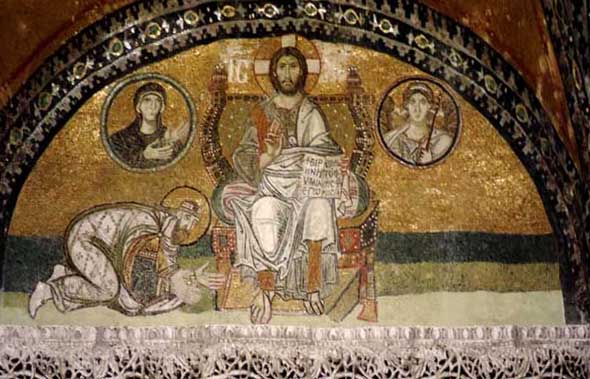 "Emperor Leon VI paying homage to Christ as Pantocrator, with medallions of Virgin Mary and Archangel Gabriel " Narthex mosaic ... Three details below: Leo VI caused a major scandal with
his numerous marriages which failed to produce a legitimate heir to the
throne. His first wife Theophano died in 897, and Leo married Zoe
Zaoutzaina,, though she died as well in 899. After Zoe's death a third
marriage was technically illegal, but he married again, only to have
his third wife Eudokia Baļana die in 901. Instead of marrying a fourth
time, which would have been an even greater sin than a third marriage,
Leo took as mistress Zoe Karbonopsina. He married her only after she
had given birth to a son in 905. Leo got his marriage recognized
by the church (albeit with a long penance attached, and with an
assurance that Leo would outlaw all future fourth marriages). See Wikipedia: Leo VI the Wise (online Dec. 2014)
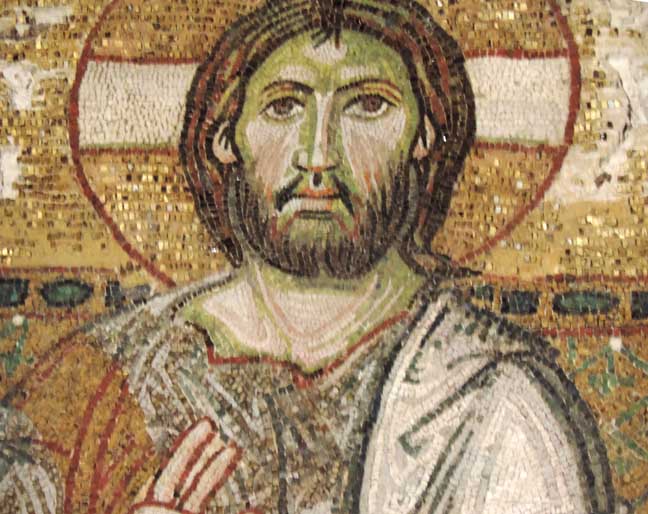 "Emperor Leon VI Paying Homage to Christ as Pantocrator" Detail #1 - 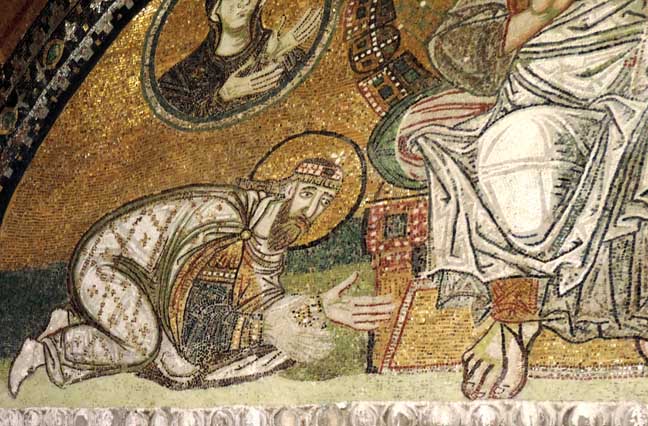 Emperor Leon VI Paying Homage to Christ as Pantocrator" Detail #2 - |
| . . |
"The Deesis: Christ, Virgin Mary, and St. John Baptist" South Gallery, ca. 1261
The gallery is laid out in a horseshoe shape that encloses the
nave until the apse. Several mosaics are preserved in the upper
gallery, an area traditionally reserved for the empress and her court.
Deesis: In
Byzantine art, and later Eastern Orthodox art generally, the Deėsis or
Deisis, is a traditional iconic representation of Christ in Majesty or
Christ Pantocrator: enthroned, carrying a book, and flanked by the
Virgin Mary and St. John the Baptist, and sometimes other saints and
angels. - Wikipedia: Deesis (online Dec. 2014)
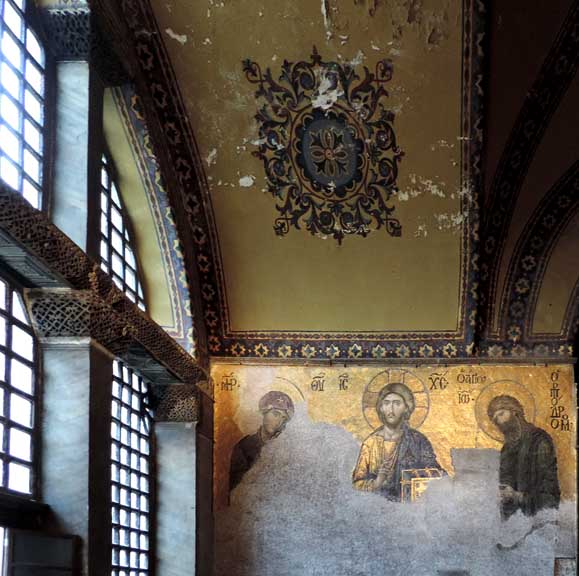 "The Deesis: Christ, Virgin Mary, and St. John Baptist" Note top fresco and windows ... 9 details below: 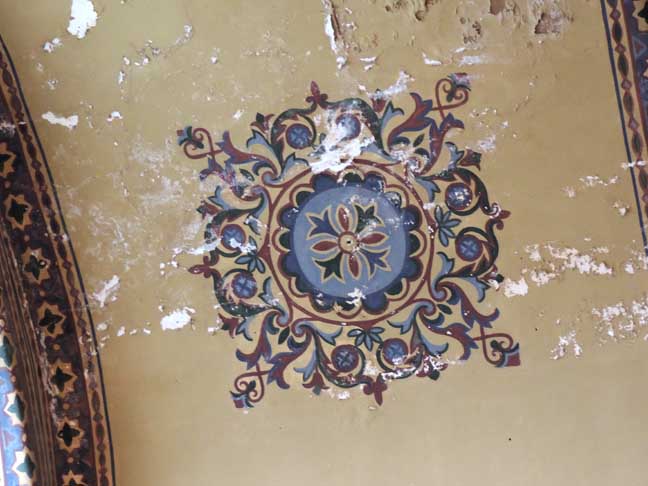 "The Deesis: Christ, Virgin Mary, and St. John Baptist" Detail# 1 - Stenciled geometric fresco above the mosaic 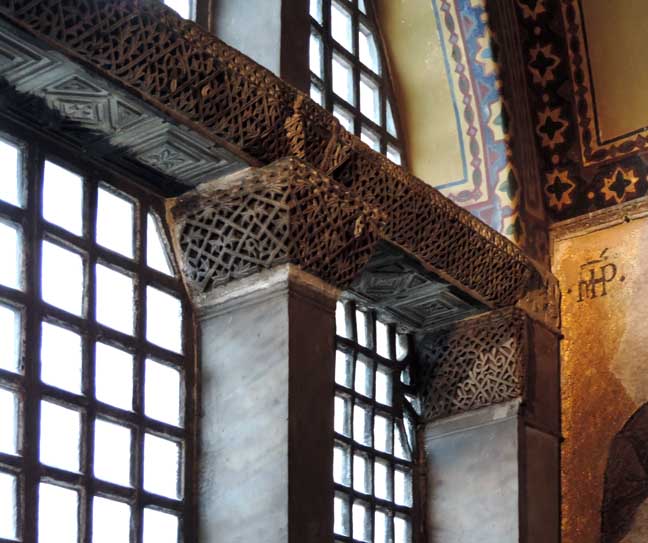 "The Deesis: Christ, Virgin Mary, and St. John Baptist" Detail #2 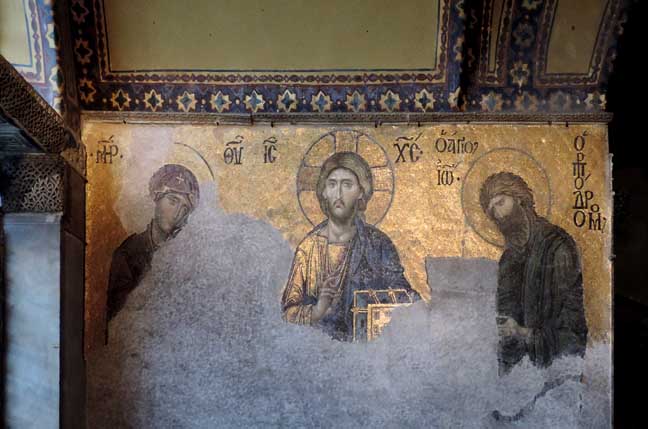 "The Deesis: Christ, Virgin Mary, and St. John Baptist" 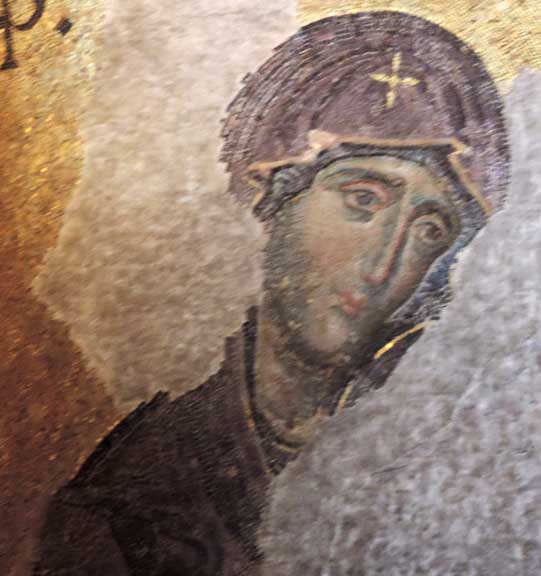 "The Deesis: Christ, Virgin Mary, and St. John Baptist" Detail #4 - Mary 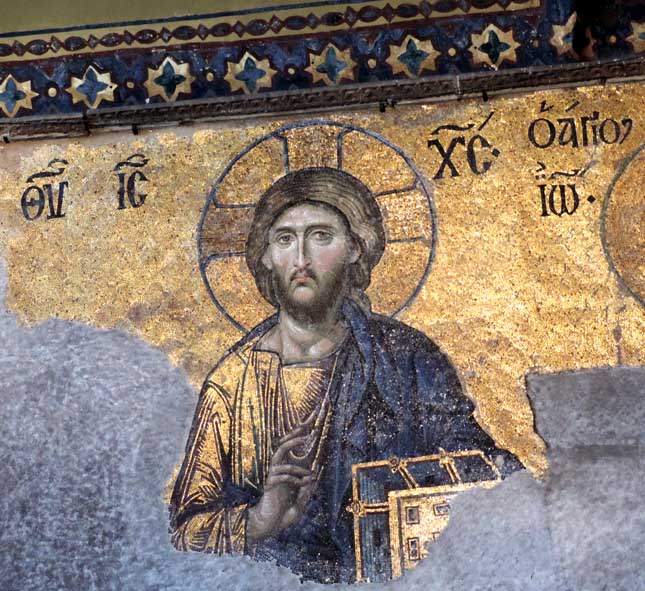 "The Deesis: Christ, Virgin Mary, and St. John Baptist" Detail #5 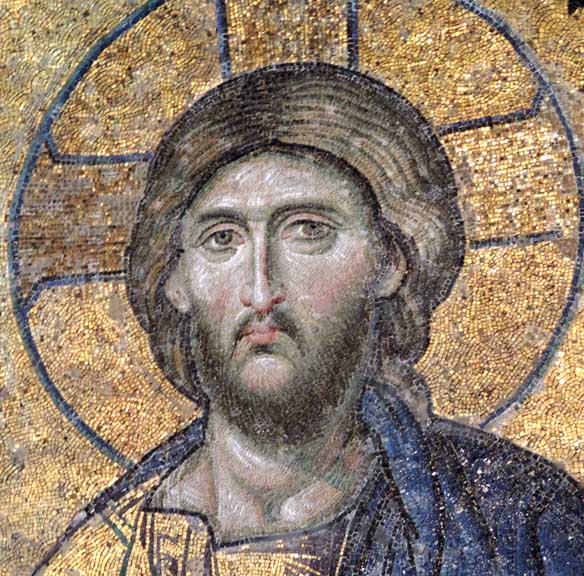 "The Deesis: Christ, Virgin Mary, and St. John Baptist" Detail #6 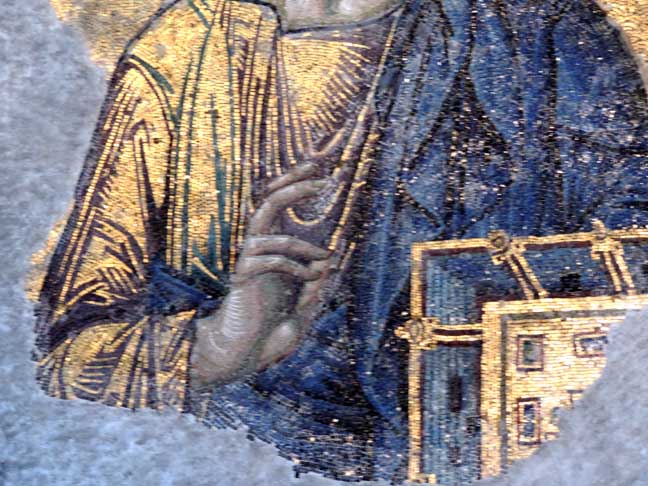 "The Deesis: Christ, Virgin Mary, and St. John Baptist" Detail #7 - Christ is giving his blessing with his right hand while holding the bible with his left. 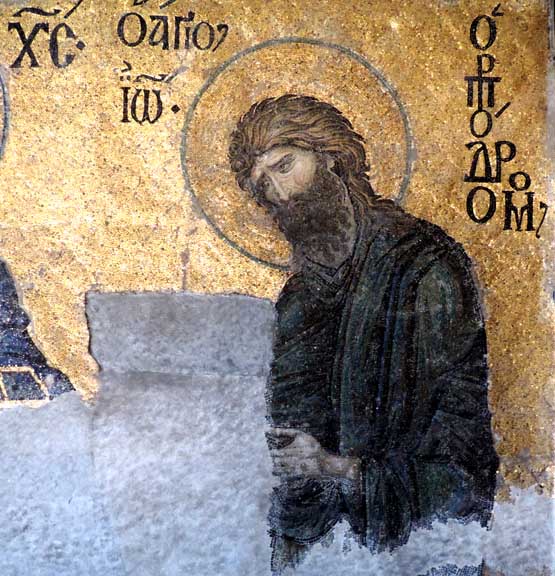 "The Deesis: Christ, Virgin Mary, and St. John Baptist" Detail #8 - St. John the Baptist 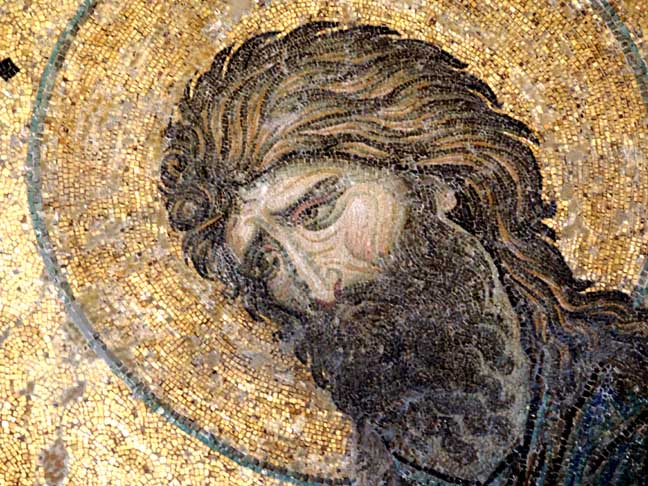 "The Deesis: Christ, Virgin Mary, and St. John the Baptist" Detail #9 - St. John the Baptist |
| . . |
"Mary, Jesus, Emperor John Comnenus II , and Empress Irene" 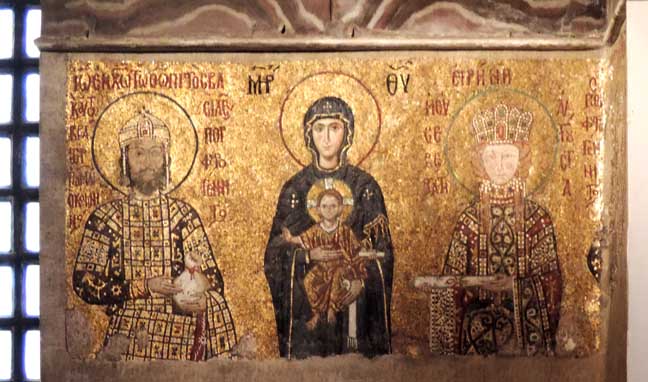 "Mary, Jesus, Emperor John Comnenus II , and Empress Irene" Upper gallery: XIIth century
"... the marriage between
young John Comnenus and the Hungarian Princess Piroska, daughter of
King Ladislaus of Hungary, was arranged in order to improve relations
between the two countries. It proved a happy marriage: the couple had
eight children. ... the empress has a fair complexion and long
blond hair in plaits; the emperor, who was nicknamed the Moor, has a
dark complexion. In the centre of the mosaic the portrait of Mary is a
rather conventional work." - Byzantine Heritage - Hagia Sophia (online Dec. 2014)
5 details below: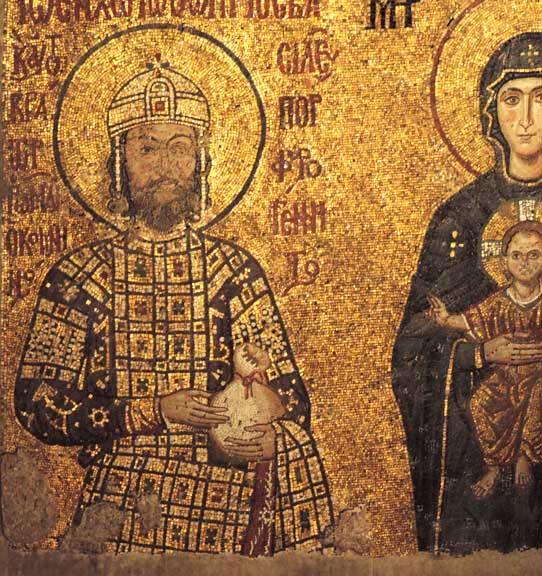 "Mary, Jesus, Emperor John Comnenus II , and Empress Irene" Detail #1 - the Emperor is carrying a purse of gold as a symbol of donations to the church. 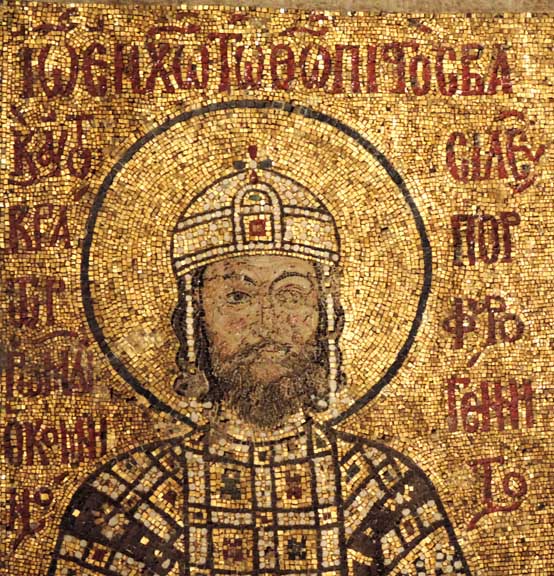 "Mary, Jesus, Emperor John Comnenus II , and Empress Irene" Detail # 2 - Emperor John Comnenus II (1118-43) 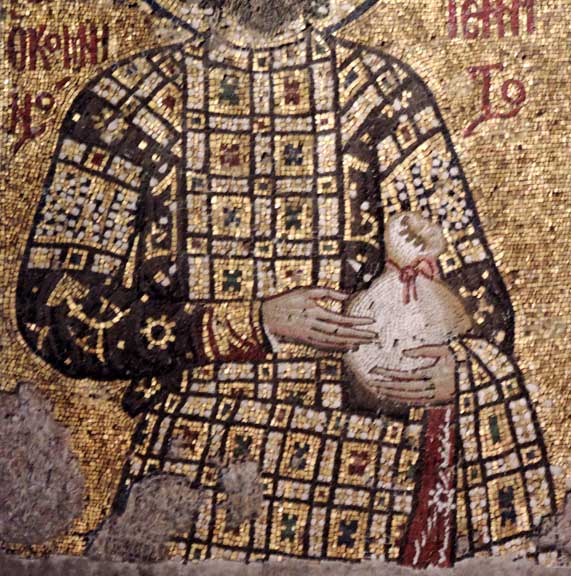 "Mary, Jesus, Emperor John Comnenus II , and Empress Irene" Detail #3 - 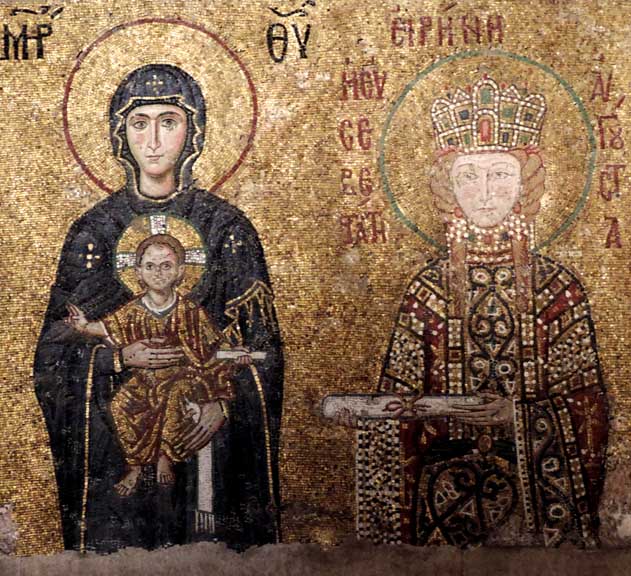 "Mary, Jesus, Emperor John Comnenus II , and Empress Irene" Detail #4 - Jesus is giving his blessing with his right hand while holding a scroll with left. Empress Irene is offering a scroll that symbolizes the donations to the church. 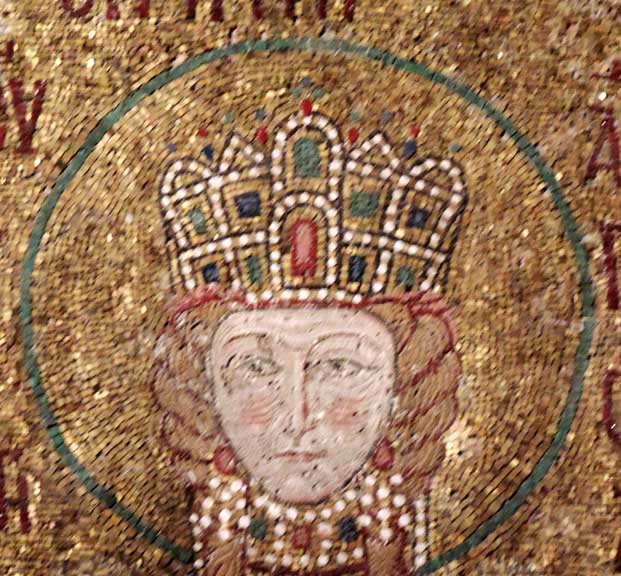 "Mary, Jesus, Emperor John Comnenus II , and Empress Irene" Detail #5 - Empress Irene |
| . . |
"Christ, Emperor Constantine IX Monomachos, and Empress Zoe" 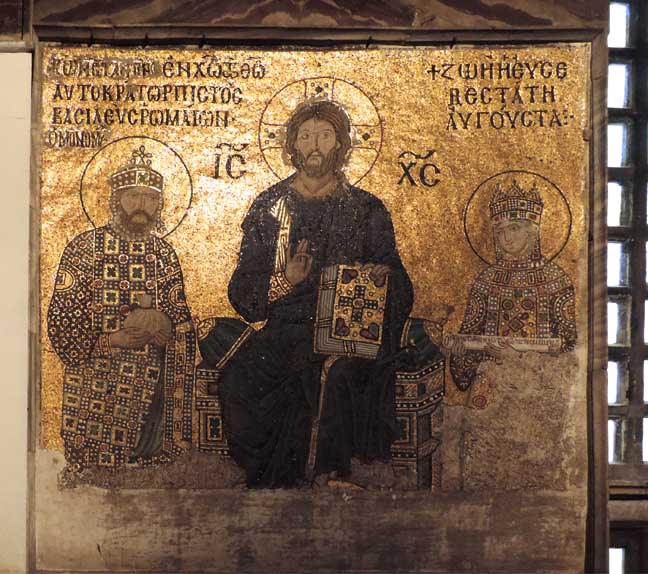 "Christ, Emperor Constantine IX Monomachos, and Empress Zoe" Eastern wall of the southern gallery, 11th century "The Byzantine court was a
dangerous place and emperors were suspicious of everyone and in
particular of their relatives. Emperor Constantine VIII (1025-28) was
wary of his potential sons-in-law and for this reason he did not allow
his three daughters to marry. Only on his deathbed he married his
daughter Zoe to his chosen heir Romanos III. Three days later he passed
away and Romanos and Zoe succeeded to the throne. She was 50 and her
husband paid little attention to her. They were portrayed in a
beautiful mosaic in the upper gallery of Hagia Sophia: Zoe looks very
humble and very small, but she had an iron will and she resented the
behaviour of her husband.
"A few years later Romanos was found dead in his bath and soon after Zoe married her chamberlain who was 24 and who became Emperor Michael IV; his portrait replaced that of Romanos in the mosaic. Zoe outlived her second husband and she became the co-ruler of his adoptive nephew Michael V. The new emperor tried to banish Zoe, but the people of Constantinople revolted and Michael was arrested, blinded and sent to a monastery where he died soon after. "Zoe became the sole ruler of the empire and she remarried a third time: the portrait of Constantine IX Monomachos (the one who fights alone) replaced that of Michael IV." - Byzantine heritage - Hagia Sophia (online Dec. 2014) 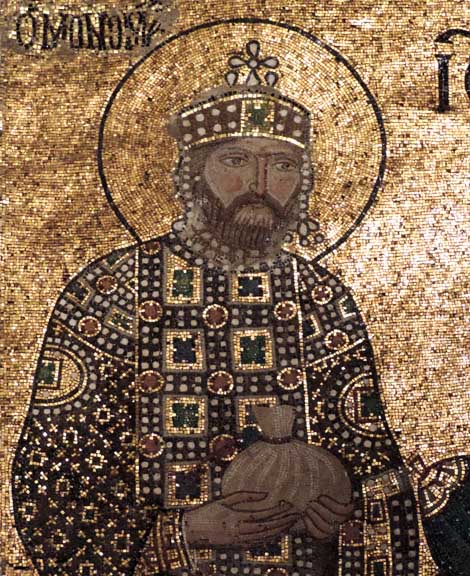 "Christ, Emperor Constantine IX Monomachos, and Empress Zoe" Detail #1 - The emperor wears the stemma, a circlet of gold encrusted with jewels and pearls. He is offering Christ the traditional apokombiom which is a purse in which the emperor carried coins to distribute on feast days.  "Christ, Emperor Constantine IX Monomachos, and Empress Zoe" Detail #2 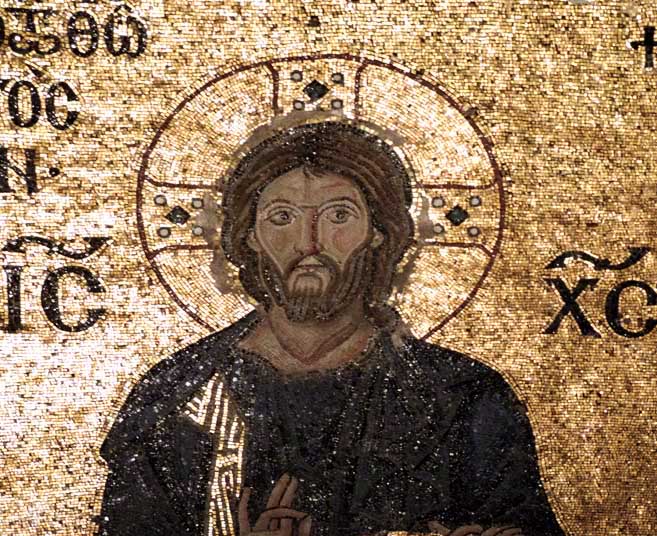 "Christ, Emperor Constantine IX Monomachos, and Empress Zoe" Detail #3 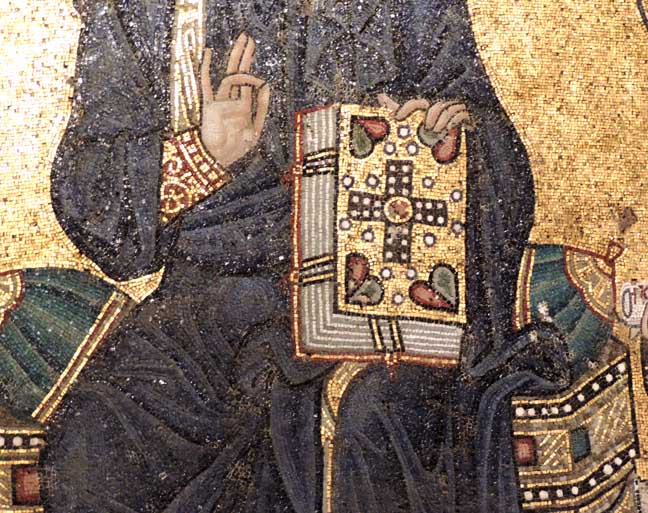 "Christ, Emperor Constantine IX Monomachos, and Empress Zoe" Detail #4 - Christ's right hand is raised in blessing 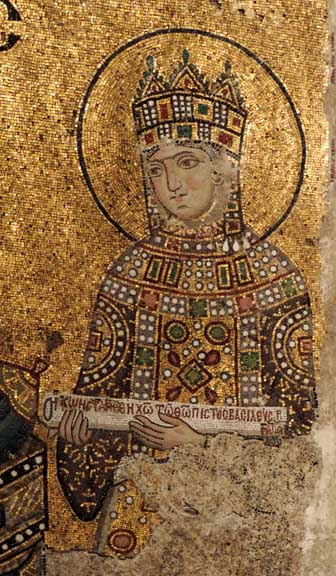 "Christ, Emperor Constantine IX Monomachos, and Empress Zoe" Detail #5 |
| . . |
| "Virgin and Child with Emperors Justinian I and Constantine I" Southwestern entrance tympanum, 944. 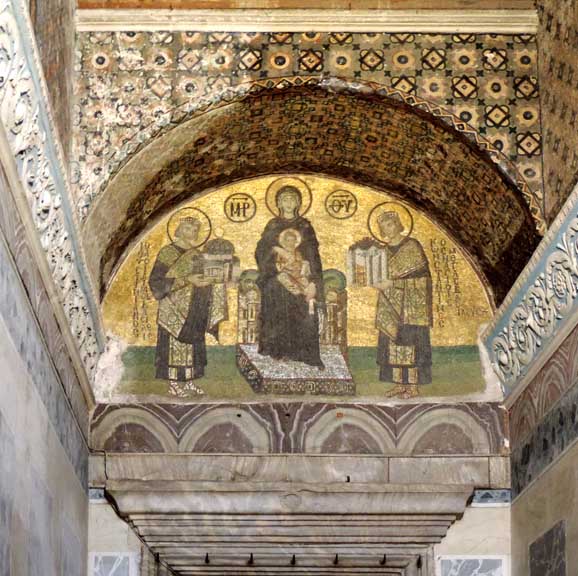 "Virgin and Child with Emperors Justinian I and Constantine I" "The subject presents a group of
two Emperors on either side of the Virgin enthroned with the Infant
Savior. The figures are inscribed with their name and
titles. In the center the Virgin with her appellation of Mother
of God. To our right, Constantine the Great as a saint; to
our left, Justinian the First; both emperors are nimbate with
halos. The Virgin holds the Infant in her lap. Constantine
carries the City that bares his name. Justinian supports in his
hands the Church of St. Sophia. The green ground beneath the
figures is presented in four horizontal layers which grow darker as
they recede. The background is bright gold mosaic which vibrates
with every pulse of light and creating an air of celestial brilliance
around the amethyst-blue figures. The mosaic is ragged along its
edges; originally it was surrounded by a border of red tessellate, of
which parts remain; at the base of the picture no less than eleven rows
are missing. - Bob Atchison: Hagia Sophia (online Dec. 2014)
5 details below: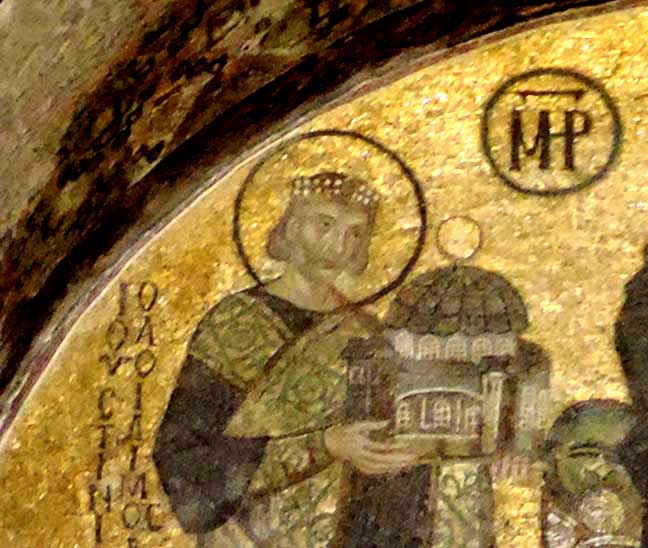 "Virgin and Child with Emperors Justinian I and Constantine I" Detail #1 - . Justinian supports in his hands the Church of St. Sophia.  "Virgin and Child with Emperors Justinian I and Constantine I" Detail #2 - 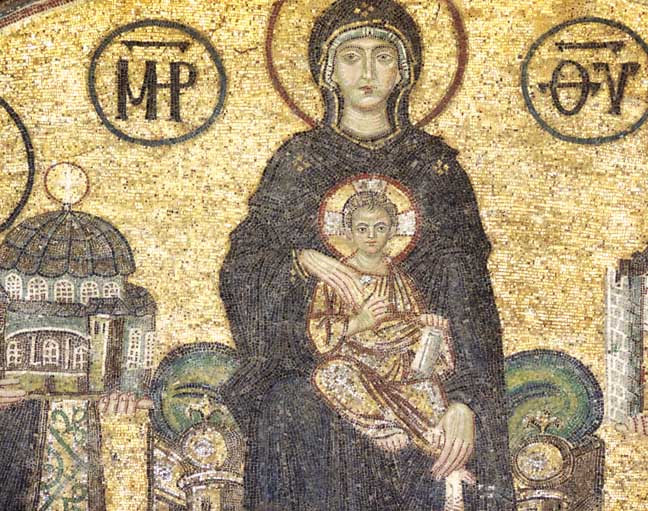 "Virgin and Child with Emperors Justinian I and Constantine I" Detail #3. "The Child is represented seated on the knees of the Virgin. He is blessing with the right hand in the manner of the Eastern Orthodox Church, the tip of the third finger touching the thumb. In the left hand he holds a scroll. ... The large dark reddish-brown pupils give depth to the expression. ... The mouth breaks gently into a smile. The general impression is that of a face filled with thoughtful alertness and radiance and the whole figure seems ablaze with light. At the same time we are aware that the artist in his characteristic Byzantine pre-occupation to endow the Child with the miraculous attributes has assigned to the body of an infant the head of an adolescent. "Around the head of the Child is a cruciform nimbus. There is some Fossati restoration in it. The hand of the child is unduly large when compared with the other limbs of the body. The artist has done this to emphasize the benediction. The bare right foot is large in comparison with the body of the Child. The left foot is less visible and was partially destroyed by a bad Fosatti restoration which is very distracting since the foot is missing toes." - Bob Atchison: Hagia Sophia (online Dec. 2014) 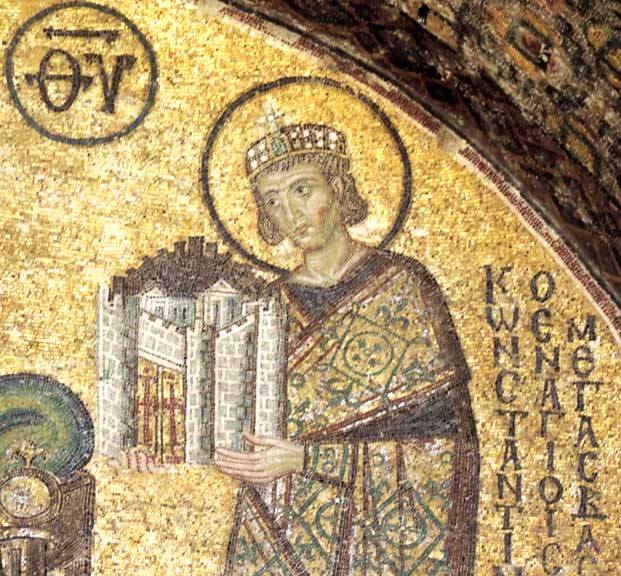 "Virgin and Child with Emperors Justinian I and Constantine I" Detail #4 - Constantine carries the City that bares his name. 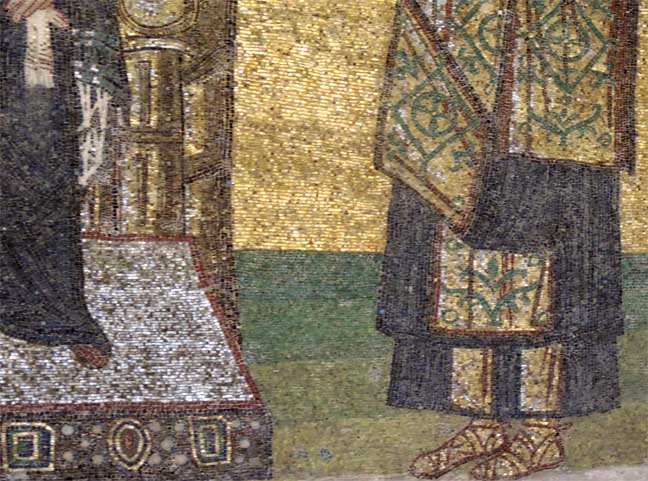 "Virgin and Child with Emperors Justinian I and Constantine I" Detail #5 - |
